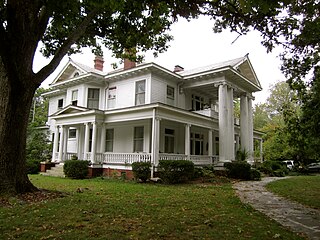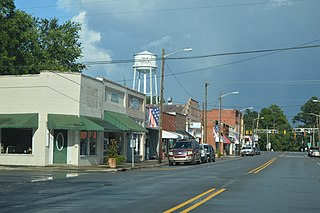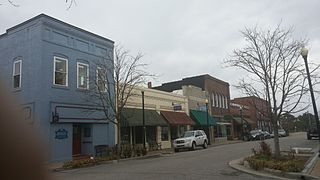
The Monroe Residential Historic District is a national historic district located at Monroe, Union County, North Carolina. It encompasses 376 contributing buildings, 1 contributing site, and 4 contributing objects in a predominantly residential section of Monroe. The district developed between about 1874 and 1940 and includes notable examples of Italianate, Queen Anne, and Classical Revival architecture styles and includes work by architects Wheeler & Stern and by G. Marion Tucker. Notable buildings include the R. V. Houston House, Houston-Redfearn House, the Belk House, J. H. Lee House, M. G. Sheppard House, Elizabeth Friedeman House, former Methodist Parsonage, Gaston Meares House, William E. Cason House, M. G. Sheppard House, and George B. McClellan House.

Halifax Historic District is a national historic district located at Halifax, Halifax County, North Carolina, US that was listed on the National Register of Historic Places in 1970 with an increase in 2011. It includes several buildings that are individually listed on the National Register. Halifax was the site of the signing of the Halifax Resolves on April 12, 1776, a set of resolutions of the North Carolina Provincial Congress which led to the United States Declaration of Independence gaining the support of North Carolina's delegates to the Second Continental Congress in that year.

Lenoir Downtown Historic District is a national historic district located at Lenoir, Caldwell County, North Carolina. The district includes 41 contributing buildings and 2 contributing objects in the central business district of Lenoir. It includes commercial, governmental, and institutional buildings in a variety of popular architectural styles including Art Deco, Art Moderne, Classical Revival and Tudor Revival. Notable contributing resources include the Center Theater (1941), O. P. Lutz Furniture Company and Lutz Hosiery Mill (1939), Dayvault's Drug Store (1937), Caldwell County Agricultural Building (1937), Courtney Warehouse, Masonic Hall, Miller Building, Confederate Monument (1910), Belk's Department Store (1928), Lenoir Building (1907), J. C. Penney Department Store, Fidelity Building (1928), and U. S. Post Office (1931). Located in the district is the separately listed Caldwell County Courthouse.

Newton Downtown Historic District is a national historic district located at Newton, Catawba County, North Carolina. The district encompasses 50 contributing buildings and 5 contributing objects in the central business district of Newton. Notable buildings include the First National Bank of Catawba County, H&W Drug Company, Belk-Brumley Department Store, Alman Furniture Company Building, Catawba County Courthouse (1924), Ervin Apartments (1936), Sanitary Grocery, Freeze Drug Store, Catawba County Library (1954), Haupt Building, City Hall and Fire Station, and Eagle Building.

Faison Historic District is a national historic district located at Faison, Duplin County, North Carolina. The district encompasses 116 contributing buildings, 2 contributing structures, and 1 contributing object in the central business district and surrounding residential area of Faison. It includes industrial, residential, and commercial buildings with notable examples of Greek Revival, Queen Anne, and Italianate style architecture. Notable buildings include the Cates Pickle Company (1931), Moore Lee Thornton Store, C. S. Hines Store, Clifton's Service Station (1933), The Walter Livingston Hicks House, Faison Pharmacy, Witherington Building (1915), Faison Depot (1888), Presbyterian Church (1918), Elias Faison House, Faison-Williams House (1853), and Witherington House (1880).

Rocky Mount Central City Historic District is a national historic district located at Rocky Mount, Edgecombe County and Nash County, North Carolina. The district encompasses 166 contributing buildings in central Rocky Mount. It includes a variety of industrial, commercial, residential, and institutional buildings dating from the late-19th through mid-20th centuries. Notable buildings include the Firestation No. 2 (1924), Union Bus Station (1951), the Railway Express Agency Building, Memorial Hospital (1937), Church of the Good Shepherd (1877), Atlantic Coastline Railroad Station (1903-1916), Imperial Tobacco Company Processing Plant (1903-1923), S. H. Kress and Company, Belk-Tyler, Grand Theater, Manhattan Theater, Holy Hope Episcopal Church (1910s), and Summerlin House (1895).

Louisburg Historic District is a national historic district located at Louisburg, Franklin County, North Carolina. The district encompasses 206 contributing buildings, 1 contributing site, 6 contributing structures, and 1 contributing object in residential sections of Louisburg included in the original 1779 town plan. It also includes a section of Louisburg College located on the old Town Commons. Dwellings date between about 1800 and the 1920s and include notable examples of popular architectural styles including Federal / Georgian, Italianate / Greek Revival, Queen Anne, Colonial Revival, Late Victorian, and Bungalow / American Craftsman. Located in the district and separately listed are the Fuller House, Williamson House, and Main Building, Louisburg College. Other notable buildings include the Shine-King House, Milner-Perry-Boddie-Dennis House, Dr. J.B. Clifton House, The Edgerton-Pruitt House, The Furgurson-Hicks House, Nicholson-Bickett-Taylor House, The Hughes-Watson-Wheless House, Bailey-Yarborough House, The Barrow House, The Neal-Webb House, The Milner-Williams-Person Place, Former Rectory-St. Paul's Episcopal Church, Hicks-Perry-Bland-Holmes House, Malcomb McKinne House First Baptist Church (1927), Louisburg United Methodist Church (1900), and Louisburg Baptist Church (1901-1904).

Downtown Greensboro Historic District is a national historic district located at Greensboro, Guilford County, North Carolina. The district encompasses 96 contributing buildings in the central business district of Greensboro. The commercial buildings were built between about 1885 and the 1930s in a variety of popular architectural styles including Italianate and Art Deco. Located in the district is the separately listed Jefferson Standard Building. Other notable buildings include the Vanstory Building, Kress Building (1929), Woolworth's, Efrid's Department Store, Montgomery Ward (1936), the Carolina Theatre (1927), Center Theatre (1948), the former Belk Building (1939), Ellis Stone/Thalhimer's Department (1949-1950), and the former American Exchange National Bank Building (1920). The Woolworth's store is notable as the site of the Greensboro sit-ins of 1960.

Raeford Historic District is a national historic district located at Raeford, Hoke County, North Carolina. The district encompasses 48 contributing buildings and two contributing structures in the central business district of Raeford. The commercial and institutional buildings, residences, and transportation-related resources include notable examples of Queen Anne- and Colonial Revival-style architecture built after 1897. Notable buildings include the B. R. and Margaret Gatlin House, J.W. and Christina McLauchlin House, Raeford Furniture Company, Hoke Drug, Bank of Raeford (1911), Aberdeen & Rockfish Railroad Passenger Depot, Johnson-Thomas Building, and Davis Sinclair Station.

Lincolnton Commercial Historic District is a national historic district located at Lincolnton, Lincoln County, North Carolina. It encompasses 62 contributing buildings and 2 contributing objects in the central business district of Lincolnton. It includes a variety of commercial, institutional, and industrial buildings dating between about 1900 and 1955. Located in the district are the separately listed Classical Revival style Lincoln County Courthouse and First United Methodist Church. Other notable buildings include the Frank Beal House, Karl L. Lawing House, Reinhardt Building, Carolina First National Bank, Central Candy and Cigar Company, Jonas Building, Wampum Department Stores, Rhodes and Corriher Company building, and Coca-Cola Bottling Company building.

Richlands Historic District is a national historic district located at Richlands, Onslow County, North Carolina. The district encompasses 90 contributing buildings, 2 contributing structures, and 2 contributing objects in the central business district and surrounding residential sections of Richlands. The district largely developed after 1880 and includes notable examples of Late Victorian and I-house style residential architecture. Notable contributing buildings include the Robert D. Thompson House (1908), Daniel Webster Murrill House (1908), the Del Barbee House (1910), the Edwards-Cox House (1915), Isaac Koonce House (1918), George Brooks House (1915), Franck House (1914), Richlands Theater (1936), J. F. Mohn Building (1936), Richlands Supply Company Building (1905), M. B. Steed Store (1911), Peoples Bank Building, Bank of Richlands (1927), First Baptist Church (1920s), and Richlands United Methodist Church (1939).

Hertford Historic District is a national historic district located at Hertford, Perquimans County, North Carolina. The district encompasses 219 contributing buildings, 2 contributing sites, 1 contributing structure, and 1 contributing object in the central business district and surrounding residential sections of Hertford. The district developed between about 1759 and 1948, and includes notable examples of Federal, Greek Revival, and Gothic Revival style architecture. Located in the district are the separately listed Perquimans County Courthouse and Church of the Holy Trinity. Other notable buildings include the Creecy-Skinner-Whedbee House, Edward Wood House, Matthews-Jacocks House, Temperance Hall (1851), Matthew H. White House, Dr. Thomas S. McMullan House (1905), Thomas Nixon House, William M. Divers House (1924), W.R. Shannonhouse Building (1895), Darden Department Store, Farmers National Bank of Hertford (1916), State Theatre (1937), Old Hertford Post Office (1915), Hertford Baptist Church (1854), and Hertford United Methodist Church (1901).

Brooklyn–South Square Historic District is a national historic district located at Salisbury, Rowan County, North Carolina. The district encompasses 65 contributing buildings in predominantly residential section of Salisbury. It largely developed between about 1875 and 1925, and includes notable examples of Federal, Greek Revival, and Late Victorian style architecture. Notable buildings include the Woodson-Overcash House, Blackmer-Propst House, Mowery-Peeler House, Keen-Bastian House, William Trott House (1905), J. W. Glover House (1920s), Cross-Crowell-Rufty Store (1920s), Burges-Lyerly-Fifty/Fifty Store (1920s), and the former St. Peter's Episcopal Church.

Mount Airy Historic District is a national historic district located at Mount Airy, Surry County, North Carolina. The district encompasses 187 contributing buildings in the central business district and surrounding industrial and residential sections of Mount Airy. They were primarily built between about 1880 and 1930 and include notable examples of Late Victorian and Bungalow / American Craftsman architecture. Located in the district are the separately listed W. F. Carter House and Trinity Episcopal Church. Other notable buildings include the Abram Haywood Merritt House (1902), William A. Estes House, Thomas Fawcett House, J. D. Sargent House (1919), Campbell A. Baird House (1913), T. Benton Ashby House, First Baptist Church (1906-1912), Mount Airy Friends (1904), Presbyterian Church (1907-1914), Merritt Building, Banner Building (1906), Prather Block, Midkiff Hardware Store, Welch Block, West Drug Store, Belk's Building, (former) Workman's Federal Savings and Loan, (former) First National Bank (1893), Bank of Mount Airy (1923), U.S. Post Office (1932-1933), and the Sparger Brothers Tobacco Factory.

Columbia Historic District is a national historic district located at Columbia, Tyrrell County, North Carolina. It encompasses 119 contributing buildings, 1 contributing structure, and 1 contributing object in the central business district and surrounding residential sections of Columbia. The district developed between about 1880 and 1944 and includes examples of a variety of popular architecture styles. Located in the district is the separately listed Tyrrell County Courthouse. Other notable buildings include Snell's Inn, Columbia Garage, Columbia Christian Church, McClees-Coffield House, Combs-Hussey House, Frederick L. W. Cohoon House, Columbia Baptist Church (1905), W. J. White Building (1931-1932), Columbian Theatre, Wesley United Methodist Church (1912), St. Andrews Episcopal Church (1909), Tyrrell County Jail, Merchants and Farmers Bank / East Carolina Bank, Tyrrell County Bank, and Columbia Theatre.

Monroe Downtown Historic District is a national historic district located at Monroe, Union County, North Carolina. It encompasses 25 contributing buildings and 1 contributing object in the central business district of Monroe. The district developed during the late 19th and early 20th centuries and includes notable examples of Late Victorian and Classical Revival architecture styles. Located in the district is the separately listed Union County Courthouse. Other notable buildings include the Hotel Joffre Building (1917-1919), Bank of Union Building (1905-1906), Belk/Bundy Building (1911), Monroe Bank & Trust Company Building (1919-1920), Monroe Hardware Company Building (1928), and Secrest Building (1928).

The Waxhaw–Weddington Roads Historic District is a national historic district located at Monroe, Union County, North Carolina. It encompasses 18 contributing buildings, 2 contributing structures, and 1 contributing object in a predominantly residential section of Monroe. The district developed between about 1897 and 1940 and includes notable examples of Prairie School, Queen Anne, and Classical Revival architecture styles and includes work by architects Charles Christian Hook and by G. Marion Tucker. Notable buildings include the Redwine Tenant House (1907), Robert B. Redwine House (1908), Heath House (1897), Edward Crow House (1916), and Crow's Nest.

Lucama Municipal Historic District is a national historic district located at Lucama, Wilson County, North Carolina. It encompasses 42 contributing buildings in the railroad town of Lucama. The district developed between about 1890 to 1930 and includes notable examples of Classical Revival, Bungalow / American Craftsman, and Victorian style architecture. Notable buildings include the Will Davis Store, Jesse Lucas Store, Lucama Depot (1905), Kinchen Barnes Store, W. J. Newsome Store, Lousetta Newsome House (1887), Dr. Ben Hackney House, and Lucama Methodist Church (1915).

Elm City Municipal Historic District is a national historic district located at Elm City, Wilson County, North Carolina. It encompasses 85 contributing buildings in the railroad town of Lucama. The district developed between about 1873 to 1930 and includes notable examples of Classical Revival, Early Commercial, and Victorian style architecture. Notable buildings include the Batts & Williams Store (1884), G. A. Barnes Store (1912), Dawes Building (1914), Elm City Bank (1920s), Holden House, A. C. Dixon House, G. A. Barnes House, W. G. Sharpe House, Dr. Robert Putney, Sr., House, and L. C. Cobb House (1927).

Elmwood Historic District–East is a national historic district located at Buffalo, Erie County, New York. The district encompasses 2,405 contributing buildings, 31 contributing structures, and 14 contributing objects in the Elmwood Village neighborhood of Buffalo. It is bounded on the north by Delaware Park, Forest Lawn Cemetery, and the former Buffalo State Asylum, on the south by the Allentown Historic District, and on the west by the Elmwood Historic District–West. This predominantly residential district developed between about 1867 and 1965, and includes notable examples of Queen Anne, Shingle Style, Colonial Revival, Tudor Revival, and American Craftsman style architecture. The district contains one of the most intact collections of built resources from turn of the 20th century in the city of Buffalo and western New York State. Located in the district are 17 previously listed contributing resources including the Buffalo Seminary, Garret Club, James and Fanny How House, Edgar W. Howell House, Edwin M. and Emily S. Johnston House, Col. William Kelly House, Lafayette Avenue Presbyterian Church, Parke Apartments, and the Unitarian Universalist Church of Buffalo. Other notable building include the Frank Lloyd Wright designed William R. Heath House (1904-1905), Herbert H. Hewitt House, School 56 (1910-1911), the Harlow House, A. Conger Goodyear house, Alexander Main Curtiss House, Nardin Academy campus, and Coatsworth House (1897).






















